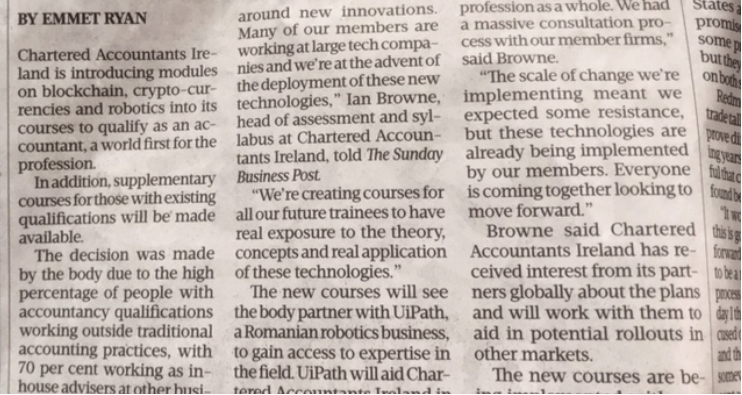40 Essential Selection Criteria to Choose an RPA Platform – Part 5 of 5
Platform configurability; embedded or accessible intelligence; the cost of maintaining an RPA platform; your system integrator; customer support and success options; and the products debugging features are key areas that need considered as you select your RPA platform.
This article is the final in our ‘Essential selection criteria to choose an RPA platform’ and one of the more significant, but often under valued, set of selection criteria.
1. System integrator – if your vendor or a 3rd party is required to get you up and running then remember to score that capability too (e.g. number of deployments to date; number of successful clients delivered for; RPA resources employed with real experience of your sector – ask to see CVs of those installing, developing and supporting your program; number of automation architects with how many successful installs they have under their belt – ask for reference sites; cloud experience and credentials – ask for reference sites; etc.).
“3rd parties and consulting companies (big or small) should only be used at the first steps of the automation journey. An approach that worked for a lot of companies is to get a capable partner to get them up and running, but in the meantime hire internal resources and train them close to the experts. You should be honest with your external partners and make crystal clear that the end goal is not to need them at all (fully in-house model). Even if your needs are extremely high and even if RPA is the top of the top priorities, it is always better to go slower and build internal capability, rather than being dependent from external companies.”
Konstantinos Vogiatzakis, Global RPA Lead at Babylon Health
2. Strength of ‘out of the box’ process library – does the vendors RPA platform come with lots of pre-built routines for the many typical market software out there or do you have to build from scratch? Can you access a repository of other customers code blocks or again do you need to begin from zero? If existing code exists this can save you considerable development expense.
3. Ease and features of product configuration – how easy is the product to setup, configure and maintain? How malleable is the RPA platform to your business?
“Democratised technology is putting solutions into the hands of front line workers, rather than the IT department. In the coming months, expect RPA vendors to provide increasingly flexible low- and no-code solutions that can be tweaked to suit the needs of individual businesses – and even, I suppose, individuals themselves.”
Ian Hawkins, Editor, PEX Network
4. Debugging features – how easy is it to find and fix the code your developers or your system integrator’s developers or / contractors developers developed?
“Software development is hard. There’s a reason powerful integrated development environments (IDEs) have evolved over the last 20 years…to make it as simple, quick and error-free as it can be. Automation is software development! Make sure your chosen platform provides a powerful and rich IDE, with features such as flow analysis, quick-fixes, step-by-step debugging and edit and continue. The improvements in speed and agility of delivery, as well as cost savings that can be gained over the lifetime of an automation programme through a great IDE are immense.”
Paul Arnold, Head of Product and Development at Cortex Intelligent Automation
5. Embedded or accessible intelligence – RPA will get you so far and is excellent for automating rules-based processes that follow a reasonably simple, but well defined logic. For more complex processes (and you will quickly discover how limited RPA can be) AI capabilities and/or integrations with 3rd party AI / ML / NLP tools is key. There are huge business benefits for organisations that can successfully deploy AI , ML and RPA. RPA and AI/ML together, known as cognitive RPA, enables you to automate more complex, value add process than either technology alone.
“To create a true digital workforce, you need to have the same capabilities as a human; acting, thinking, analysing. Without cognitive and analytical capability, RPA is a little more than a macro, with limited use.”
Edward Halsey, RPA Enterprise Account Manager
6. Cost of maintaining the solution Buying and configuring an RPA platform represents only a small proportion of the costs your organisation will bear. There are many up front costs (e.g. licences, staff hiring and training, consultancy, cloud costs, etc.) and many ongoing costs that need built into your business case (e.g. annual maintenance and upgrade costs, staff wages and emoluments, code maintenance costs, etc.). RPA can support deliver a great deal of monetary and non-monetary business returns (e.g. improved CSAT or staff NPS scores, reduction in process variability risk, etc) but make sure you account for all costs in your business case before you begin your RPA journey.
“Understand exactly where your organisation’s aspirations lie. Then decide what that will look like in terms of cost in 3 plus years time. Investing in an enterprise RPA platform takes time and money; but implemented and executed correctly will see your organisation get its money back many times over.”
Gourav Datta, RPA and Intelligent Automation Delivery Lead
7. RPA Product work successfully with Citrix (ok, so prove it)? – if you run on Citrix (screen images) then you need to really test the vendors product to determine if it will work for your organisation. This can be a deal breaker for many organisations.
“After the company has the process architecture and they have clearly defined the high level uses cases of RPA and which problems it solves, then the respective systems involved should be one of the criteria of the vendor selection.”
Konstantinos Vogiatzakis, Global RPA Lead at Babylon Health
8. Customers support options (multiple geographies and languages) – what support services does your vendor offer, in what time zone, over how many hours per day (per geography) and what are the SLAs associated with that service? and how much does each service offering cost? Does your vendor provide a comprehensive suite of documents to help you successfully build and run your RPA product e.g. architecture; security; integrations; comprehensive RPA run-book or playbook available; typical process suited to RPA; code libraries; cloud install methods; training and support materials; etc. As you grow your robot numbers and spread RPA into multiple, follow the sun, geographies your need for vendor query or bug fix support will grow (vendors note these are called ‘bug fixes’ not ‘feature updates’ in the real world!).
“Do you get your own customer success manager? If not, why not? That tells me that the vendor just wants to sell me a piece of software, not that they have any plan or buy-in as to how successful I am with it. I’m ambitious – I want my vendor to match that ambition and have a plan in place on how they’re going to push me to 100, 200 or 500 bots!”
Edward Halsey, RPA Enterprise Account Manager
Selecting the right RPA tool or indeed intelligent automation tools is key to the success of your RPA journey. Get your tool selection right and you give yourself every chance of success. Get your tool of choice wrong and your costly business error may result in a loss of money and indeed your job.
What do you consider to be the most important criteria for selecting an RPA platform?
This article is the final part of a #RebootRPA series. #RebootRPA is a series of articles written by real world experts to help you overcome the challenges of selecting, implementing and scaling an RPA platform.
- RPA Reboot: RPA 101
- 14 rules for Robotic Process Automation (RPA) and Intelligent Automation (AI) success
- If you are not willing to go all in, then don’t put on your RPA swimsuit.
- The biggest lie told to RPA customers – 50 robots equals success
- 40 essential selection criteria to choose an RPA platform part 1 of 5
- 40 essential selection criteria to choose an RPA platform part 2 of 5
- 40 essential selection criteria to choose an RPA platform part 3 of 5
- 40 essential selection criteria to choose an RPA platform part 4 of 5
If this could benefit someone else tag them and share this.
Free to reuse: If you want to post this article on your LinkedIn page then please feel free to do so. The more information we share within the RPA community the more likely businesses are to succeed with this excellent technology.
Further Help: If I can help you in any way please do reach out.
Note: The views expressed above are my views and not those of my employer.






Leave a Reply